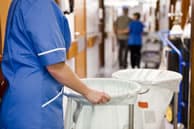Cleaning and Custodial Services
Overview
Approximately 2.3 million workers in building custodial services occupations.1 Projected employment for 2031 is 2.6 million (custodial services).2 Nearly 724,000 maids and cleaners work in hotels, health care facilities, and other buildings. 3
Cleaners perform tasks such as the following:
- Sweeping and mopping floors
- Removing trash
- Cleaning surfaces
- Moving furniture and lifting bulk material to clean an area
- Disinfecting tasks (health care facilities)
The tasks often result in exposure to these hazards:
- Shiftwork
- Heavy lifting, prolonged standing, and regular bending
- Exposure to body fluids or other infectious agents
- Handling cleaning agents
The hazards may result in conditions such as the following:4
- Psychosocial stress
- Musculoskeletal disorders
- Infectious diseases
- Dermatologic diseases, allergies, and respiratory diseases


Resources
NIOSH has resources available to help cleaners and their employers and workers recognize and prevent or reduce risks during their work.
Employers
Safe and Proper Use of Disinfectants to Reduce Viral Surface Contamination in Correctional Facilities
This document describes viral pathogens that may be present in correctional facilities. It lists steps to reduce viral surface contamination through the safe and proper use of disinfectants.
Protecting Workers Who Use Chemical Cleaners |En español
This document provides information to employers about practices to help keep workers safe when working with cleaning chemicals, including green cleaning products.
Effects of Skin Contact with Chemicals: Guidance for Occupational Health Professionals and Employers |En español
This document explains how occupational health professionals and employers can identify and manage the risk of chemical exposures to the skin and prevent injury and illness associated with dermal exposure risks.
Workers
Protect Yourself: Cleaning Chemicals and your Health |En español
This poster contains guidelines for workers to protect their health while working with cleaning chemicals.
Effects of Skin Contact with Chemicals: What a Worker Should Know |En español
This document helps employees identify hazards and reduce the risks and health effects of chemical exposure.
Safe and Proper Use of Disinfectants to Reduce Viral Surface Contamination in Correctional Facilities (poster)
This poster, based on a Workplace Solutions document, recommends steps in plain language to reduce viral surface contamination through safe and proper use of disinfectants.
International Chemical Safety Cards
The Chemical Safety Cards, available in several languages, offer safety and first aid information about hundreds of chemicals.
Workers in Healthcare Facilities
Guidelines for Environmental Infection Control in Health-Care Facilities
These recommendations were developed by CDC and the Healthcare Infection Control Practices Advisory Committee (HICPAC). Sections are included on cleaning and disinfecting environmental surfaces and patient care areas, and cleaning spills of blood and other body fluids.
References
- BLS [2022]. Occupational outlook handbook: janitors and building cleaners (summary). https://www.bls.gov/ooh/building-and-grounds-cleaning/janitors-and-building-cleaners.htm
- BLS [2022]. Occupational outlook handbook: janitors and building cleaners (job outlook). http://www.bls.gov/ooh/building-and-grounds-cleaning/janitors-and-building-cleaners.htm#tab-6
- BLS [2022]. Occupational employment and wages, May 2017. 37-2012 Maids and housekeeping cleaners. https://www.bls.gov/oes/current/oes372012.htm
- Charles LE, Loomis D, Demissie Z [2009]. Occupational hazards experienced by cleaning workers and janitors: a review of the epidemiologic literature. Work 34:105‒116
- OMB [2022]. North American Industry Classification System. Washington, DC: Executive Office of the President, Office of Management and Budget. https://www.census.gov/naics/reference_files_tools/2022_NAICS_Manual.pdf
